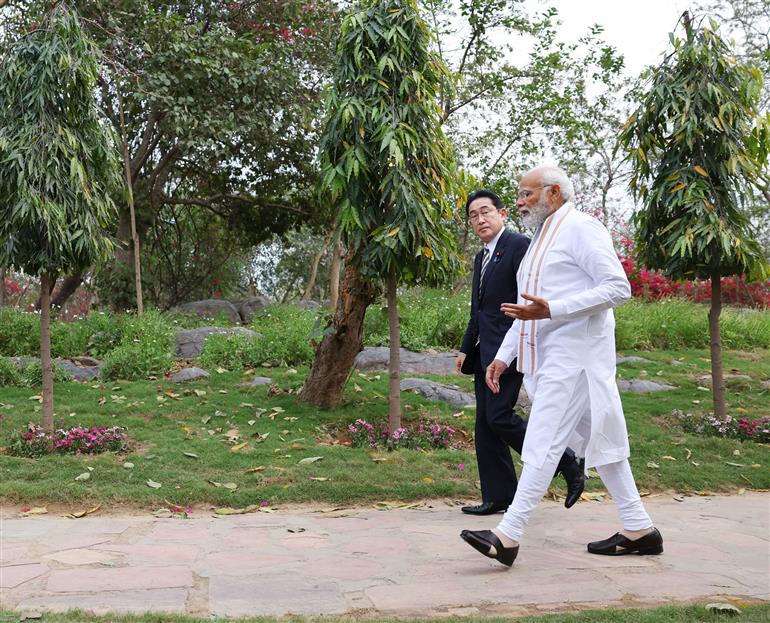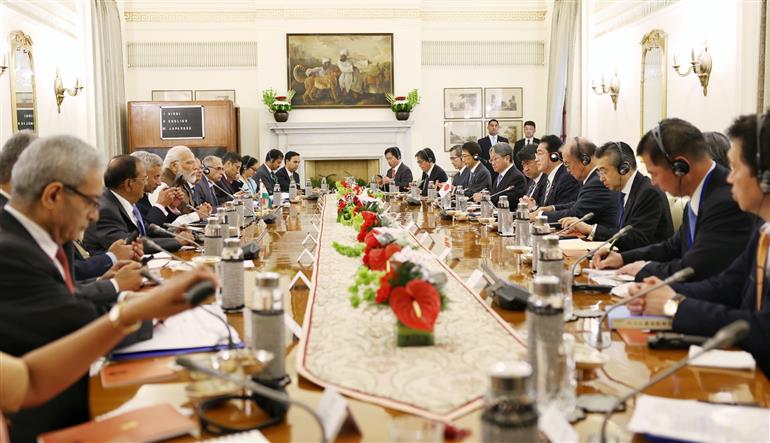
Prime Minister Narendra Modi with Japanese PM Fumio Kishida at Buddha Jayanti Park in New Delhi on March 20, 2023.
New Delhi: 2023 is a pivotal year for both India and Japan as chairs of the two major international groupings – India as the President of the G20 and Japan as the Chair of G7. Through the G20 presidency, India is working with partner countries, including Japan to provide a greater voice to issues of interest to developing countries, in particular the countries of the Global South.
The visiting Japanese Prime Minister Kishida Fumio today invited Prime Minister Narendra Modi to the G7 Summit in Hiroshima in May this year, which the latter accepted. During their meeting, both also talked about their own respective priorities. While Modi explained at length India’s priorities for G20, Kishida talked about his priorities and Japan’s priorities for G7. These two also formed an important component of the bilateral conversation.
Indian Foreign Secretary Vinay Kwatra later told media persons it is natural that when talks are held between two leaders in the context of two summits, then what are the common points in the priorities, are discussed. “The agenda of the G7 is different from the agenda of the G20 because the way the G7 and the G20 are structured, not only the structure of the countries but also the structure of the agenda is very different. But one thing is clear in this, both the leaders agree, as far as the question of the voice of the Global South, as far as their views, as far as their voices are concerned, it is in the global interest to include all of them in some way or the other under the agenda of the G20. There was a clear discussion about this,” he said. According to him, it was not just a good opportunity for both leaders to present their thinking, and their priorities regarding the two Summits, but it was very important to develop a clear understanding of those priorities, of the perspective behind those priorities, of what the key driving forces are for those priorities and see how those priorities can also enrich the discussions in the two platforms. “So when my Prime Minister speaks about digital transformation, digital public goods, sustainable lifestyles, elements like these being the priorities of G20, not just for India, for G20, but also for the larger global South, obviously, that can enrich the agenda for the G7 discussions also,” Kwatra said. He added: “If some points of cooperation and coordination emerge after this discussion, then it is a matter of taking it forward at a later stage. But as I said, the structure of both the institutions is different,” he added.

The two leaders also discussed regional issues of significance, including the Indo-Pacific apparently in the context of China’s aggressiveness. They spoke about the challenges that they face in the region and how India and Japan and other like-minded countries can work together to address those challenges. Their discussion however, not just focussed on challenges but also focussed on cooperation, particularly in the wider expanse of the Indo-Pacific, on how to take the other countries of the Indo-Pacific together and that is cut across several domains, to build resilient and trustworthy supply chains, and to mitigate some of the challenges that the development template of many of the countries within Indo-Pacific face in terms of the debt burden etc.
Kwatra informed that all that formed part of a larger broad platform of discussion insofar as the region and sub-region specifically and the larger field of Indo-Pacific is concerned.
The two leaders also held substantive discussions on key topics of bilateral cooperation that included the domain of Defense and Security, Economic Partnership, Climate and Energy – including energy transition, People-to-People exchanges, Skill Development, Innovation.
Modi put on the table that one of the areas of very strong cooperation between India and Japan could be co-innovation, co-design, and co-creation. One of the key elements of the conversation also was investment collaboration, and investment partnership in this space, and Prime Minister Modi made it very clear to Prime Minister Kishida that when it comes to private sector investments in the field of Defence and also when it comes to Foreign Direct Investment in the field of Defence, those two sectors are completely open in India. “The Japanese companies are not only invited but are also encouraged to harness the opportunity and advantages that are inherent in the Indian manufacturing ecosystem, the policy framework liberalization that the government of India has undertaken in the field of Defense, link it to Make in India, not just for India but also for the rest of the world, also do it in a manner that the products manufactured here are part of not just regional supply chains but also global supply chains and also which helps in building trusted supply chains in the field of Defense,” Kwatra explained.
In terms of concrete outcomes of the visit, there were two documents that were signed on the sidelines. One was a renewal of the Memorandum of Cooperation (MoC) on the Japanese Language that was originally signed in 2017 essentially focusing on higher-level language learning. And second document which was signed was the Exchange of Notes for the 4th tranche instalment of JICA ODA Loan of JPY 300 Billion on the Mumbai-Ahmedabad High-Speed Railway Project, roughly INR 18,000 crores. The Ministry of Environment of Japan and the Ministry of Environment, Forest and Climate Change of India, too signed an Aide Memoire essentially on the Joint Crediting Mechanism (JCM) that has been under discussion for quite some time between the two countries.
– global bihari bureau





